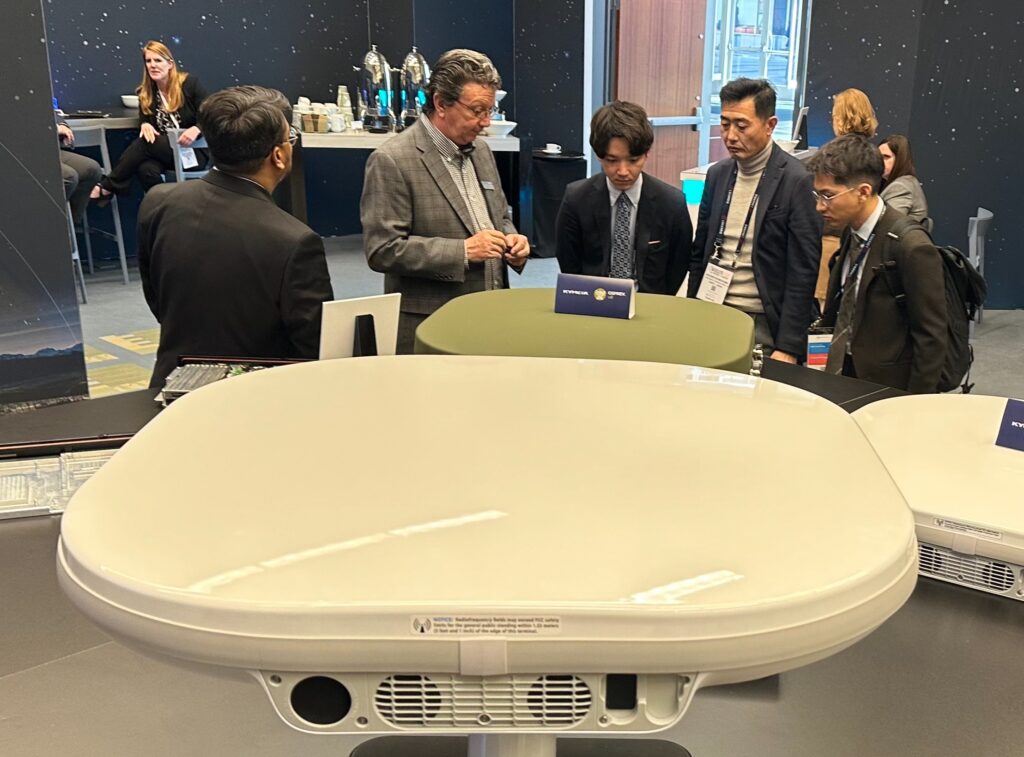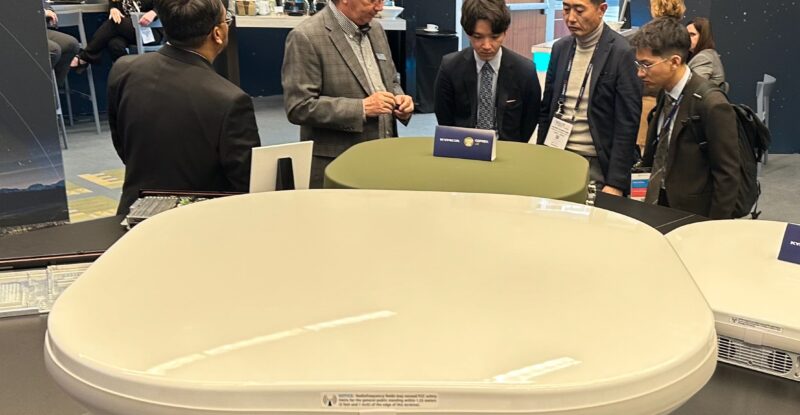Capable of switching between multiple orbits and multiple networks, including via Eutelsat OneWeb LEO, Kymeta Corporation’s electronically scanning, flat-panel satellite terminal technology is supporting connectivity for on-the-move platforms including in the military.
Heat makes soldiers detectable in the field. As such, the low thermal signature and low power of Kymeta’s metamaterials-based technology (as opposed to phased array, for example) holds appeal for armed forces, affixed atop MRZR tactical vehicles. Kymeta terminals have also long powered maritime applications using proprietary technology that leverages the scale and manufacturing capabilities of the flat panel TV industry.
But given the unique integration and certification challenges in aviation, Redmond, Washington-based Kymeta is eyeing securing a key strategic partner to address the inflight connectivity market, company senior vice president of product Lilac Muller revealed to Runway Girl Network at Satellite 2024 in Washington, D.C.
“For inflight connectivity, there is the D0-160 process and the qualification and all of that. That is a big hurdle for us because that’s not our area of expertise. For us it was an easier path to go get MIL-SPEC certification for our terminal to put it in the hands of the military. Or to go get certification for commercial markets. So, we’ve done what is our core competency,” she said.
“For aero it’s not our core competency. It’s not that we can’t do it. We would probably look to partner with someone that knows how to do it that can take this unique technology and integrate it into an aero-based product. That’s just not our core competency.”

In partnership with Eutelsat OneWeb, Kymeta last year launched a new brand, the Peregrine u8 which is focused primarily on maritime. Here it is seen in the foreground on a maritime pedestal in Kymeta’s suite at Satellite 2024. Separately, an Osprey u8 HGL-branded hybrid GEO/LEO/LTE terminal purpose-built for the military and seen in green in the background, is already shipping out of Kymeta’s facility in Woodinville, Washington. This marks the first commercially available multi-orbit terminal and the first multi-orbit terminal on Eutelsat OneWeb’s LEO network, according to Kymeta.
Though it has not formally entered the aviation space, Kymeta is armed with much of the core technology needed to facilitate next-gen aero applications.
For instance, LEO flat panel antennas and LEO throughputs are already having a disruptive force in the maritime industry including because of their ease of installation. “So it takes minutes to install this guy,” Muller said in reference to Kymeta’s Peregrine u8 maritime kit. “It’s really simple. I mean, Starlink is simple. This is simple. You literally just plug it in, you mount it, you secure it into place, you plug in cable power. You turn it on and it works.”
Multi-orbit terminal configurations bring more capabilities, as Kymeta’s land-mobile solution is now accommodating in the military. “This year at the SATShow, what we really are launching is our multi-orbit terminal so it can switch between GEO, LEO, OneWeb and cellular. Actually it can switch between two GEOs, an embedded GEO and an external GEO because everybody has their GEO network of choice, an embedded LEO/OneWeb and cellular. So four different connections which gives a full PACE plan: primary, ancillary, contingency, emergency, so full four redundancy systems of changing back and forth,” explained Muller.
“Now we’ve done that for the military because the military has been asking for that for many, many years. But we’re now seeing applications in enterprise. We have enterprise customers who are asking, ‘can you make a solution for us?’ We’re registering the demand. Our technology is certainly capable of doing that and we’re evaluating where we’re going to go from here. But really the uniqueness of our technology is allowing us to switch between multi-orbits and multi-networks. That is what we really specialize in.”
LEO-only and multi-orbit LEO/GEO configurations are also having a serious moment in aviation. For instance, SpaceX’s Starlink LEO-only service is now fleet-wide on JSX’s fleet, has debuted on Hawaiian Airlines A321neos and is presently being tested on an airBaltic A220-300. And Intelsat has announced several airline customers for its multi-orbit IFC solution, inclusive of Eutelsat OneWeb LEO service which provides SLAs.
With such a strong portfolio, a leap into aero is surely just a matter of time for Kymeta.
In the past, the firm had working arrangements with the likes of Inmarsat-now-Viasat for aero and, interestingly, Panasonic in a maritime play which did not bear fruit. When asked if Kymeta is looking at reestablishing those conversations as it explores possible aero partnerships, Muller said: “Potentially. There’s nothing I can announce at this time. But I can tell you that those type of companies are all looking at the marketplace and they’re talking to all antenna technologies out there. And so, I can’t comment on who we talk to and where the talks are at, but I can tell you that they are incredibly diligent in vetting and doing due diligence on all kinds of technologies.”
Just as Kymeta’s technology can support multi-orbit/multi-network configurations, it is also capable of supporting multi-beam (simultaneous GEO and LEO satellite connections, and in time MEO) — which is considered the next frontier in aviation.
“Our technology is absolutely compatible with that,” Muller told RGN. “Part of the reason why we have not developed it further is because a lot of our solutions are for the commercial market and that adds cost, and so we certainly have the technology and the capability. We’ve not yet productized it at this point.”
But here again, a key integration partner likely needs to come first, with Muller noting to RGN that: “The right partnership will likely be a requirement for us to productizing our technology for aero market.” She would not be drawn on a timeline for a possible entry into the sector.
Related Articles:
- Viasat still determining NGSO ambition and its pertinence to IFC plan
- Telesat on why the wait for Lightspeed will be worth it in aero
- Neuron arms airlines with data to make digital experience decisions
- Eutelsat OneWeb to support inflight connectivity from September 2024
- OneWeb-powered Galileo to be competitively priced to Starlink: Gogo
- Stellar Blu to develop multi-orbit, multi-beam aero ESA with BAE tiles
- Intelsat makes the case for multi-orbit IFC versus LEO-only
- Panasonic, Kymeta part on good terms as industry giant studies new tech
Featured image credited to Mary Kirby












